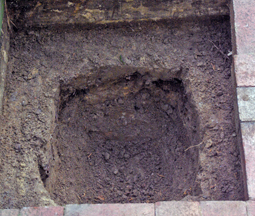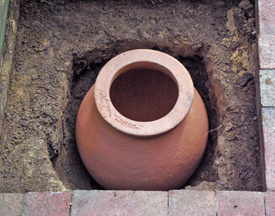 On our visit to the country Georgia last September, our driver laughed at us because we wanted to see a hole in the ground. Both Kathy, myself and two apprentice winemakers, one from Austria and the other from Ukraine were excited to see a hole in the ground. However, those laughing or smiling did not see what we saw. Rather than seeing the site for what it was, we saw the site for what it would someday become. We saw a marani with several qvevri buried and a winemaker making wines in the traditional Georgian method that has now been added to the UNESCO list of Cultural Heritage.
On our visit to the country Georgia last September, our driver laughed at us because we wanted to see a hole in the ground. Both Kathy, myself and two apprentice winemakers, one from Austria and the other from Ukraine were excited to see a hole in the ground. However, those laughing or smiling did not see what we saw. Rather than seeing the site for what it was, we saw the site for what it would someday become. We saw a marani with several qvevri buried and a winemaker making wines in the traditional Georgian method that has now been added to the UNESCO list of Cultural Heritage.
I brought back a qvevri to the United States from Georgia when we visited this spring. It is not large, just 24 liters. I’ve considered different things to do with it. Such as build a frame and keep it in the house. That way I could make wine in it and talk about the ancient Georgian winemaking process. However, common sense prevailed and I ended up digging a hole in the ground. I did not have to dig very deep, just deep enough to completely bury the qvevri under a few inches of soil.
 So now I have a hole in the ground. When I look at it though, I see the potential of making a qvevri wine. I see nature’s cooling jacket where the ground temperature will remain somewhat constant during the months wine is aging in the qvevri. Just to give an idea, I photographed the qvevri in the hole. It is actually several inches below the surface. Before burying it I have to slowly heat the qvevri to 70ºC and coat the inside with beeswax that is heated to 110ºC. The beeswax will seal the pours of the vessel and provide some help with keeping bacteria out of the wine. Then I will bury the qvevri and search for a source of Viognier grapes.
So now I have a hole in the ground. When I look at it though, I see the potential of making a qvevri wine. I see nature’s cooling jacket where the ground temperature will remain somewhat constant during the months wine is aging in the qvevri. Just to give an idea, I photographed the qvevri in the hole. It is actually several inches below the surface. Before burying it I have to slowly heat the qvevri to 70ºC and coat the inside with beeswax that is heated to 110ºC. The beeswax will seal the pours of the vessel and provide some help with keeping bacteria out of the wine. Then I will bury the qvevri and search for a source of Viognier grapes.
Cheers,
Terry



Leave a Reply